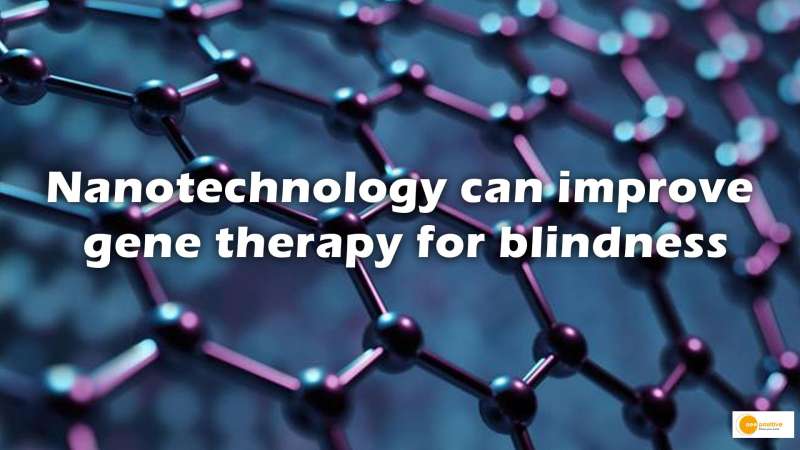

Technology has led to the development of many new research outcomes that have helped to diversify the fields that science covers leading to further development in new ideas and technology. One of the most recent outcomes that have taken place is the use of nanotechnology for curing genetic blindness by improving gene therapy. Using this nanotechnology, a new approach in the field of gene therapy has helped to improve how physicians would treat inherited forms of blindness.
The new gene therapy method encloses gene-editing molecules inside a shell of lipid nanoparticles. This scientific illustration shows the lipid nanoparticle shells of this kind of approach and these appear as fuzzy beige balls after they have been injected into the eye. A team of researchers from the Oregon Health and Science University and the Oregon State University has developed an approach that uses tiny lipid nanoparticles, lab-made balls of fat, to deliver strands of messenger ribonucleic acid also called the mRNA, inside the eye. The mRNA will be designed to create proteins that would edit vision-harming gene mutations to cure genetic blindness. In a study published in
Science Advances, this research team demonstrated how the lipid nanoparticle delivery system targets light-sensitive cells in the eye, called photoreceptors, in both mice and nonhuman primates. The nanoparticles are coated with a peptide that researchers have identified as being attracted to photoreceptors.
Gaurav Sahay, the corresponding author of the study, who has a Ph.D., and an associate professor in the OSU College of Pharmacy who also has a joint research
appointment at the OHSU Casey Eye Institute, states that in our body, the peptides present are like a zip code and that the lipid nanoparticles are the same as an envelope that helps to send gene therapy in the mail. He also says that the peptide makes sure that the mRNA is precisely delivered to the photoreceptors cells that have not been able to be targeted by us with the lipid nanoparticles. The co-author of the study, Renee Ryals, who has a Ph.D., and is also an Assistant Professor of Ophthalmology at the OHSU School of Medicine is also a scientist at the OHSU Casey Eye Institute states that there are more than 250 genetic mutations that have been linked to inherited retinal diseases, but only one has an approved gene therapy and by improving the technologies that are used for gene therapy, more treatment options can be provided to prevent blindness and according to the study, lipid nanoparticles could help to do so.
In 2017, the Food and Drug Administration approved the first gene therapy as a treatment for an inherited form of blindness. Many patients have experienced improved vision and have been spared blindness after receiving the therapy and this is sold under the brand name Luxturna. A modified version of the adeno-associated virus, or AAV, is used for delivering gene-revising molecules. The gene therapies of today’s world largely rely on AAV, but it has also got some limitations. This virus is relatively small and cannot physically contain gene-editing machinery for some complex mutations. In addition to this, AAV-based gene therapy can only deliver DNA, which results in the continuous creation of gene-editing molecules that may lead to unintended genetic edits.
Lipid nanoparticles are the best alternatives because they do not have size constraints like AAV. In addition to this, lipid nanoparticles can deliver mRNA, which keeps the gene-editing machinery active for a short period to prevent off-target edits. This high potential of lipid nanoparticles was further proved by the success of mRNA-based COVID-19 vaccines, which also used lipid nanoparticles in delivering the mRNA. They were also the first vaccines to be authorized for COVID-19 in the United States, and this could be possible due to the speed and volume at which they were manufactured.
In this study, Sahay, Ryals, and their colleagues have demonstrated that a peptide-covered lipid nanoparticle shell can be directed toward the photoreceptor cells in the retina tissue in the back of the eye that enables vision. As the first proof of concept, mRNA with instructions that can make green fluorescent protein was placed inside the nanoparticles. The research team used various types of imaging techniques to examine the eyes that have already been treated. The retinal tissue of the animals glowed green which illustrated the reaching of the lipid nanoparticle shell to the photoreceptors and that the mRNA that it delivered successfully, entered the retina and created green fluorescent protein. This research marked for the first time that lipid nanoparticles have targeted photoreceptors in a nonhuman primate.
The scientists are then working on follow-up research to quantify the amount of the green fluorescent protein that is expressed in animal retinal models. They are also working on developing a therapy with mRNA that can carry the code for gene-editing molecules. Sahay and Ryals will continue their task of developing the nanoparticle gene therapy delivery system with the support of a new, $3.1 million grant from the National Eye Institute of the National Institute of Health.


